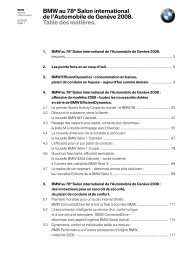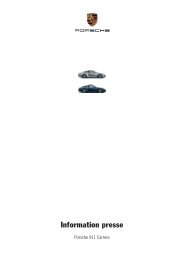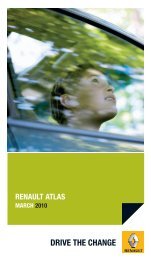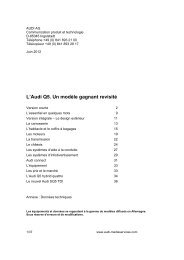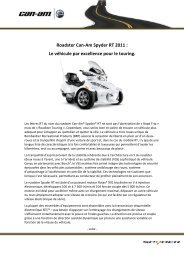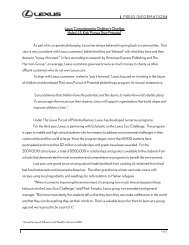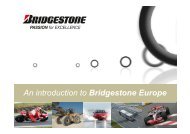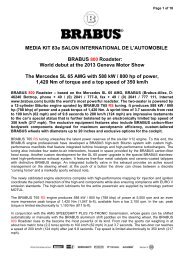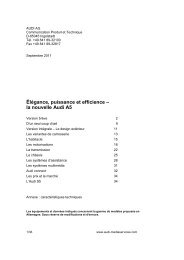EU Label Flyer - MotorShow
EU Label Flyer - MotorShow
EU Label Flyer - MotorShow
Create successful ePaper yourself
Turn your PDF publications into a flip-book with our unique Google optimized e-Paper software.
europeAn tyre LABeL reguLAtion<br />
(eC.1222/2009)<br />
As of 1 november 2012, new tyre label regulations are in force to help<br />
promote safer, more economical and more environmentally friendly road<br />
transport in europe. the new labels indicate tyre performance in three key<br />
areas: braking in the wet, exterior noise and rolling resistance.<br />
In addition to these basic criteria, Bridgestone is pleased to provide you with<br />
detailed information about other critical factors to help you make an informed<br />
decision. Because while the information contained in the new tyre labels is<br />
important, it only tells part of the story when it comes to the performance of your<br />
tyres. It is also important to realize, e.g., that optimum fuel efficiency and wet grip<br />
performance depends a great deal on maintaining correct tyre pressure.<br />
obligations at the point of sale:<br />
From 1 November 2012, the following criteria must be followed<br />
at the point of sale:<br />
1) Any car or van tyre* produced after 30 June 2012 on display or visible to<br />
customers must either carry the <strong>EU</strong> official label from the manufacturer OR show<br />
a copy of the label in immediate proximity to the tyre. Distributors must provide<br />
buyers with label information for all products before sale, even if they are not<br />
on display. <strong>Label</strong>ling information must be displayed on all technical promotional<br />
material (manuals, brochures, leaflets and catalogues), including websites.<br />
2) When offering tyres for sale (on the phone,<br />
in person, on-line…), Distributors must provide<br />
the customer with the label information.<br />
3) Fuel Efficiency class, Wet grip class, and the<br />
external Rolling Noise values must be provided to<br />
the end consumer either on or together with the<br />
invoice.<br />
* Some tyres are excluded, such as off-road, studded or racing tyres<br />
1222/2009 - C1<br />
B B<br />
72 dB<br />
tyre safety Matters.<br />
Check your tyres before you drive.<br />
Your tyres are all that stand between you and potentially life-threatening situations<br />
on the road.<br />
To ensure your safety, it is essential to keep them correctly inflated and replace them<br />
when worn or damaged.<br />
Worn tyres significantly increase your stopping distance in the wet while<br />
underinflated tyres consume more fuel, have a reduced lifespan and seriously<br />
compromise the handling of your vehicle.<br />
three tips for safer tyres<br />
1. Check your tread depth and replace worn tyres well in time.<br />
2. Check your tyre pressure at least once a month.<br />
3. Check for damage and irregular wear.<br />
Bridgestone Europe continues its commitment to the European Road Safety Charter,<br />
the European Commission's road safety initiative with the overall objective to reduce<br />
annual road fatalities in Europe by a further 25.000. As a signatory to the Charter and<br />
through its targeted activities Bridgestone presents itself as a European road safety<br />
role model. In the pursuit of these objectives, we aim to conduct at least 30.000 tyre<br />
checks.<br />
Bridgestone europe nV/sA<br />
Kleine Kloosterstraat 10 - 1932 Zaventem, Belgium<br />
www.bridgestone.eu<br />
european<br />
tyre regulation<br />
What you need to know about…<br />
tyre LABeLLing<br />
1222/2009 - C1<br />
B B<br />
72 dB
1222/2009 - C1<br />
1222/2009 - C1<br />
B B<br />
72 dB<br />
european tyre <strong>Label</strong><br />
reguLAtion (eC) no 1222/2009<br />
B B<br />
72 dB<br />
1222/2009 - C1<br />
B B<br />
FueL eFFiCienCy<br />
7 classes from g (least efficient)<br />
to A (most efficient)<br />
Wet grip<br />
One of the factors influencing the fuel efficiency of a motorized vehicle<br />
is the tyre’s Rolling Resistance. A tyre resists rolling essentially because it<br />
deforms when rotating, resulting in a loss of energy in the form of heat.<br />
The higher the deformation, the higher the tyre’s rolling resistance, and<br />
consequently the more fuel that is required to move the vehicle forward.<br />
In other words, lower rolling resistance means lower fuel consumption<br />
and therefore lower vehicle emissions, including CO 2 .<br />
The effect varies depending on the vehicle and driving conditions.<br />
However, the difference between a g and an A class for a complete<br />
set of tyres could reduce fuel consumption by up to 7.5 %* and even<br />
more for trucks.<br />
*Source: European Commission’s impact Assessment SEC (2008) 2860.<br />
72 dB<br />
7 classes from g (worst wet<br />
grip) to A (best wet grip)<br />
The most important role of a tyre is<br />
to provide safety in all conditions.<br />
Wet grip is one of the most important<br />
performance characteristics,<br />
reflecting the capacity of the tyre to<br />
brake on a wet road.<br />
The effect may vary depending on<br />
the vehicle and driving conditions.<br />
However, in the case of full braking,<br />
the difference between a g and<br />
an A class for a complete set of tyres could be<br />
up to 30% shorter braking distances (e.g. for<br />
a typical passenger car this could equate to a<br />
braking distance of up to 18m shorter)*.<br />
A braking difference of 18 meters is around 4 car lengths. For your safety and that of other<br />
road users a high grip grade is recommended.<br />
18 meters (80 kph full brake)<br />
*Source: European Commission’s impact Assessment SEC (2008) 2860.<br />
1222/2009 - C1<br />
B B<br />
72 dB<br />
eXterior<br />
noise<br />
Traffic noise is an important environmental issue. It is determined by the<br />
intensity of the traffic, the type of vehicle, the driving style and tyre-road<br />
interaction. Exterior noise levels are split into 3 categories and measured in<br />
decibel (dB) in comparison with the new European tyre exterior noise levels to<br />
be introduced until 2016. The noise pictogram displays the categories while the<br />
black arrow next to the pictogram indicates the noise level as an absolute value.<br />
• 1 black sound wave<br />
(= 3dB already less than the future European limit)<br />
• 2 black sound waves<br />
(= already compliant with the future European limit)<br />
• 3 black sound waves<br />
(= compliant with the current European limit)<br />
Note that external tyre rolling noise is not related to interior vehicle noise<br />
Ask For More…<br />
The <strong>EU</strong> commission aims to increase awareness for safety and the environment.<br />
When changing a set of tyres however, it comes to brand, model and preferences.<br />
The 3 criteria represented by the labels are only a small part of the factors which<br />
determine tyre performances.<br />
FUEL EFFICIENCY<br />
EXTERIOR NOISE<br />
FueL<br />
noise / CoMFort<br />
WeAr<br />
It is important to consider more than the 3 <strong>EU</strong> labelling criteria when selecting the<br />
tyre that matches your driving requirements.<br />
• tyre characteristics<br />
dry oVerALL<br />
Wet<br />
Sport / Touring / Ecological<br />
Dry braking performance, high speed stability<br />
Resistance to hydroplaning<br />
Durability<br />
Comfort etc.<br />
• Winter performance (snow & ice)<br />
WET GRIP<br />
• driving style and operation (speeds, roads, load etc.)<br />
• Vehicle type (engine, power, aerodynamics etc.)<br />
The vehicle and tyre maintenance (tyre pressure, vehicle alignment, shock absorbers,<br />
brake pads, etc.) is as important to secure a safe and comfortable drive.<br />
A tyre expert will be able to guide you through your requirements and suggest<br />
a suitable tyre for you.



